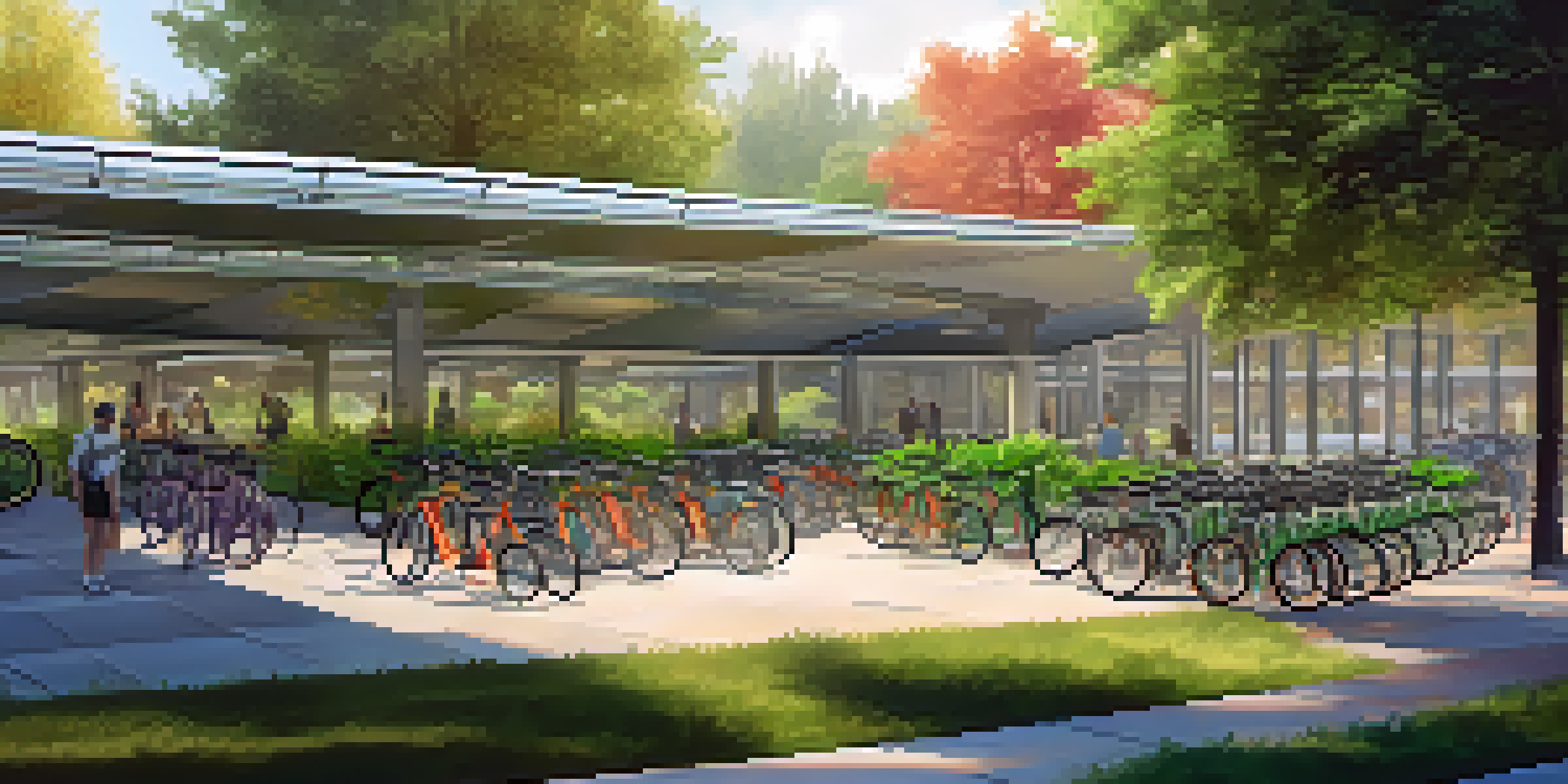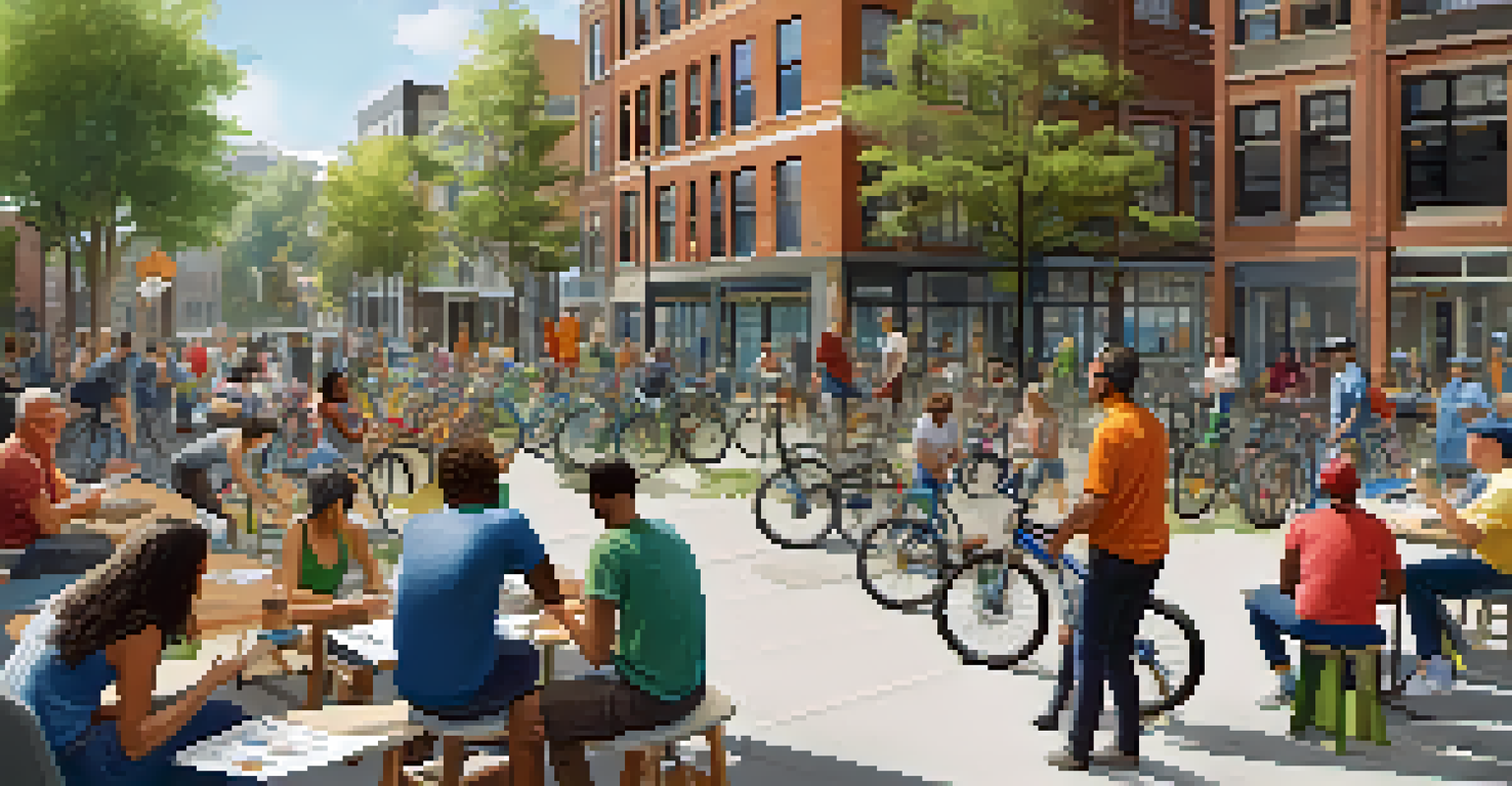The Role of Bike Parking in Urban Bicycle Infrastructure

Understanding the Importance of Bike Parking
Bike parking is a crucial element of urban bicycle infrastructure, serving as the gateway to a seamless cycling experience. When cyclists know they have safe, convenient places to park their bikes, it encourages more people to choose cycling as their primary mode of transport. This not only reduces traffic congestion but also promotes a healthier lifestyle for urban dwellers.
The bicycle is a curious vehicle. Its passenger is its engine.
Imagine walking into a grocery store and having nowhere to park your car; the same discomfort applies to cyclists. Without adequate bike parking, people may opt for driving instead, which defeats the purpose of promoting sustainable transport. Therefore, investing in bike parking facilities is essential for cities aiming to increase cycling rates.
Moreover, a well-planned bike parking system can enhance the overall aesthetic of urban spaces. When bike racks are placed thoughtfully, they can contribute positively to the streetscape, making cities more inviting and pedestrian-friendly.
Types of Bike Parking Solutions
There are various types of bike parking solutions that cater to different needs and urban environments. From simple bike racks to more secure bike lockers, the options vary in terms of security, convenience, and capacity. For instance, a basic bike rack may serve casual cyclists, while commuters may prefer enclosed lockers for added safety.

Another innovative solution is the use of bike hubs or parking garages, which can accommodate a larger number of bicycles in a compact space. These facilities often come with amenities like repair stations, showers, and even charging stations for e-bikes, making them appealing to daily commuters. This multifunctional approach enhances the overall cycling experience.
Bike Parking Boosts Cycling Rates
Providing safe and convenient bike parking encourages more people to choose cycling as their primary mode of transport.
Cities can also consider integrating bike parking with public transport systems. By creating seamless transitions from bike parking to train or bus stations, urban planners can encourage multimodal transport options, making it easier for people to incorporate cycling into their daily routines.
Safety and Security Concerns
Safety and security are paramount when it comes to bike parking. Cyclists are often concerned about theft or vandalism, which can deter them from using their bikes regularly. Therefore, incorporating high-quality locks and secure structures in bike parking designs is essential for fostering a sense of trust among users.
Cycling is not a hobby, it's a lifestyle.
Furthermore, well-lit and visible bike parking areas can enhance safety for cyclists, especially during early morning or late evening hours. Cities should prioritize placing bike racks in prominent locations, ensuring they are easily accessible and not hidden away in dark corners.
Engaging the local community in discussions about bike parking can also lead to better security measures. For example, involving residents in the planning process can help identify areas that may require additional surveillance or lighting, ultimately creating a safer environment for cyclists.
Incorporating Bike Parking into Urban Planning
Effective urban planning must integrate bike parking as a fundamental component of the transportation network. This requires collaboration between city planners, local businesses, and cycling advocates to create a comprehensive strategy that addresses the needs of all stakeholders. By considering bike parking in the early stages of development, cities can avoid costly retrofits down the line.
Moreover, incorporating bike parking into zoning laws can ensure that new developments include adequate facilities. This proactive approach not only benefits cyclists but can also increase foot traffic for local businesses, as more people feel encouraged to ride rather than drive.
Community Engagement Enhances Design
Involving local residents in the planning process leads to bike parking solutions that better meet the needs of cyclists.
Additionally, cities should promote public awareness campaigns highlighting the benefits of bike parking. Informing residents about the availability and advantages of these facilities can shift public perception and encourage more people to embrace cycling as a viable commuting option.
The Environmental Benefits of Bike Parking
Bike parking plays a significant role in supporting environmental sustainability efforts in urban areas. With fewer cars on the road, cities can experience reduced greenhouse gas emissions, leading to cleaner air and improved public health. By facilitating cycling through accessible bike parking, cities can make a tangible impact on their carbon footprint.
Moreover, promoting cycling as a primary mode of transport can help reduce the need for extensive road infrastructure. This not only saves public funds but also preserves green spaces that might otherwise be lost to road expansion. By prioritizing bike infrastructure, cities can create a more sustainable urban environment.
The collective environmental benefits of increased cycling and improved bike parking can also inspire other cities to adopt similar initiatives. As urban areas worldwide grapple with climate change, sharing success stories can foster a global movement toward more sustainable transport solutions.
Encouraging Community Engagement in Bike Parking Design
Community engagement is vital when designing bike parking solutions that genuinely meet the needs of local cyclists. Involving residents in the planning process can lead to better outcomes, as they can provide valuable insights into their daily cycling habits and preferences. Hosting workshops or surveys can be effective in gathering this information.
Moreover, communities can take ownership of bike parking facilities by participating in maintenance and upkeep. When locals feel a sense of responsibility for their bike racks, they are more likely to ensure they remain clean and functional. This not only fosters community spirit but also enhances the overall user experience.
Sustainable Future for Urban Cycling
Emphasizing bike parking as part of urban planning can significantly reduce traffic congestion and environmental impact.
Lastly, creating events around bike parking, such as 'Bike to Work' days or local cycling festivals, can further engage the community. These initiatives can highlight the importance of bike parking and encourage more people to consider cycling as a viable option for their daily commute.
The Future of Bike Parking in Urban Areas
As cities continue to evolve, the future of bike parking looks promising. With the rise of smart technology, we can expect to see innovations such as app-based parking systems that allow cyclists to locate and reserve spots in real-time. This level of convenience can significantly enhance the cycling experience and attract more users.
Moreover, the integration of bike sharing programs with dedicated bike parking can create a more cohesive transportation network. By allowing users to easily switch between personal bikes and shared bikes, cities can maximize the efficiency of their cycling infrastructure.

Ultimately, the future of bike parking will hinge on a commitment to sustainability and community engagement. As urban areas strive to create more bike-friendly environments, the role of bike parking will undoubtedly become increasingly vital in promoting healthier, more sustainable cities.